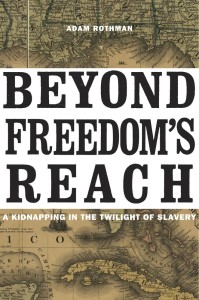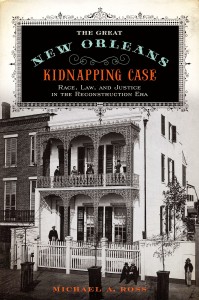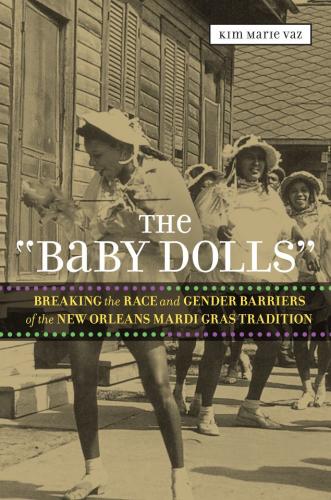Fighting for Freedom: Free Women of African Descent in New Orleans and Beyond
Delivered at the Tennessee Williams/New Orleans Literary Festival on Saturday, March 28, 2015 in New Orleans, Louisiana at the panel “Sensational New Orleans Kidnapping Cases” with Michael Ross, Adam Rothman and Kim Vaz-Deville.

Thank you Kim Vaz for organizing the panel and thank you Adam and Michael for the opportunity to reflect on your work here at the Tennessee Williams Festival.
My reflection on the two books comes from thinking about what these kidnapping cases have to say about the history of women of African descent in New Orleans, along the Gulf Coast, and in what can reasonably described as New Orleans’ Atlantic world.
 In The Great New Orleans Kidnapping Case: Race, Law, and Justice in the Reconstruction Era and Beyond Freedom’s Reach: A Kidnapping in the Twilight of Slavery Ross and Rothman offer us a rich glimpse into a unique moment in New Orleans history.
In The Great New Orleans Kidnapping Case: Race, Law, and Justice in the Reconstruction Era and Beyond Freedom’s Reach: A Kidnapping in the Twilight of Slavery Ross and Rothman offer us a rich glimpse into a unique moment in New Orleans history.
Describing sensational kidnapping cases occurring in the aftermath of the Civil War and in the midst of a general emancipation of the nation’s slaves, each case highlights the tenuous nature of freedom and the struggle to give the word meaning in a world recently post-slavery and in a city with diverse constituents. New Orleans social and political terrain was and is motley, and the struggle to define freedom and black citizenship occurred in a city comprised of Afro-Creoles and Anglo-Blacks; Republicans from the North, Unionist Democrats and die hard Confederates from across the South; Jacobin French and recently arrived Irish; enslaved Africans and people of African descent born in the Americas; as well as free people of African descent both born free, recently emancipated and freed by proclamation as a result of the War Between the States.
Of these, certainly those with the most at stake were free and enslaved women, children, and men of color.
 It is not surprising, then, to find that the struggle over freedom at the heart of each case revolved around the testimonies, experiences, and representations (particularly in the press) of women of African descent.
It is not surprising, then, to find that the struggle over freedom at the heart of each case revolved around the testimonies, experiences, and representations (particularly in the press) of women of African descent.
During the eighteenth and nineteenth centuries, enslaved and free women of color were central to New Orleans life and black community formation. From the opening of the French slave trade to the Gulf coast in 1719, enslaved women labored as spiritual and health practitioners (including at Charity Hospital), domestics, laundresses, cooks, and vendors, as well as in gangs on plantations. Some of the first enslaved women to secure freedom did so as the aides, domestics, nurses, and, at times, consorts or children of men in French employ. That the majority of ships arriving during the French period embarked from what is today Senegal and Gambia, and in a relatively short period of time (20 odd ships between 1719 and 1731, with only one more in 1743), initiated and fostered the development of an Afro-Creole Gulf Coast culture, visible today in contemporary foodways, musical, and spiritual practices.
After Spain seized control of the city in 1769, and particularly with the institution of coartación¹, women and children of African descent predominated among slaves legally freed from bondage—despite the tendency of enslaved populations to be weighted towards men as a result of slave importations and slaveowners purchasing choices. It was during the Spanish period slaves found the greatest opportunity to secure their freedom and women played a crucial role in the population of enslaved and free people of which developed. As free persons, free women of color could and did accumulate wealth and invest in property—land, homes, and stores. By buying, selling, and renting real estate, or by purchasing and leasing slaves, free women of color guaranteed themselves a regular income. Both enslaved and free women of color also labored in markets, as street vendors, and participated in frontier economies. Enslaved and free women of color raised families and participated in communities formed through rituals of baptism, Catholic marriage, and by standing as godparents. Whether enslaved or free, women of African descent did not hesitate to express their sense of justice if they believed themselves wronged. The cases under discussion today occurred after emancipation, but it is important to tie both into a broader history of women challenging slaveowners, employers, colonial officials, and each other in the courts to secure stolen persons as well as property, defend their freedom or secure manumission, mediate business conflicts or property exchanges, and more.
Just as it is not surprising to find enslaved and free women of African descent using the courts to defend their own, it is also not surprising to find women moved across a broad geographic space. The interconnectedness of the ports—from New Orleans to Mobile, from Havana to Cap-Français, from Gorée and Saint-Louis to Pensacola and Charleston—gave slaves and free people of color in one place access to those in the others. From the 1720s, free and slave persons circulated between Atlantic ports, seeking new opportunities and escaping threats. Women of color could be found even then, migrating from Martinique to New Orleans in search of kin or absconding from the Gulf Coast to Havana to escape undesirable husbands. Moving on fast forward, it was by “riding these Atlantic circuits” (as Martha Jones has described it) during the first decade of the 19th century that free women and children of African descent found their way to New Orleans, predominating among people of color caught in the 1809-1810 expulsion of French refugees from Cuba and escaping the violent conflagration which would come to be known as the Haitian Revolution. Adding their resources and skills to New Orleans’ existing free population of color, free women of color came to manage a significant proportion of property and wealth attributed to that community as a whole. In a survey of over 900 property records generated between 1794 and 1866 and catalogued by the Vieux Carré Survey at the Historic New Orleans Collection, close to 435 involved exchanges of property by or between a free woman of color. And this is just within the boundaries of the French Quarter.
This is part of the context in which the Molly Digby and Rose Herera cases emerge. A rich Atlantic world filled with women of African descent who owned property, navigated complicated kinship relations (many of them across status), and who demanded their rights from colonial and national officials.
Over the course of the American/antebellum period, however, opportunities and rights accrued by free people of color as a whole began to close down. After the acquisition of Louisiana by the United States, the territorial legislature placed manumission in the hands of elected officials, canceling coartación and diminishing opportunities for freedom accordingly. Upon becoming a state, Louisiana prohibited free men of color from access to suffrage, a sign of things to come. The acquisition of Louisiana also opened the South to an in-migration of Anglo-American slaveowners from what would become known as the Upper South (Virginia, Maryland, especially) and led to the rise of a domestic slave trade which routed through New Orleans. The city came to host the busiest slave market in the country—even as it was also home to its largest free black population outside of the North.
In 1811, a failed slave revolt, one of, if not the largest in North America, sufficiently terrified state political and military officials into catering to the free population of color — seen by some as likely to aid a slave revolt and by others as more likely to protect the state against black insurgents. But by 1830, rising anti-slavery agitation from across the country frightened lawmakers into passing or attempting to pass draconian measures against all non-whites within the state’s boundaries. One of the more infamous was the 1830 registration act which required all free people of color who arrived in the state after 1825 to leave and all those who arrived before 1825 to register (at a cost) or risk fines and imprisonment. Subsequent laws required recently manumitted slaves to leave the state within a certain number of days while others required all free men of color to leave the state or select a guardian who would vouch for their good character. Meanwhile, manumission remained in the hands of the state legislature, which persisted in restricting access to freedom for thousands of Louisiana’s enslaved, many of whom continued to arrive in the city on their way to plantations along the Gulf Coast and across the Cotton South.
In the face of such antagonism, life for enslaved and free people of color in New Orleans grew extremely difficult. After 1836, real estate owned by free people of color dropped by 32 percent.² At the same time, New Orleans’ antebellum black community fought to survive and do more than survive—to create legacies that would last generations, to protect community members and kinfolk, and to build as much lived autonomy as possible even in a city of slaves. Despite manumission  restrictions, during the 1830s and 1840s, 1/3 of manumission petitions were originated by free people color, many requests to free kinfolk. Among free women of color, women like Saint-Domingue refugee Marie Couvent, who passed away with enough property to endow a school for orphans, continued to accumulate wealth and property when and where they could.³ Some owned dry goods stores, some continued to operate boarding houses….and some owned laying-in homes as the Murray sisters did. Others, like Rose Herera, survived as best they could as slaves,watched their children kidnapped to the Caribbean, and waited until war, federal military might, and the changing laws of the nation could give them the opportunity to demand justice for themselves and their progeny.
restrictions, during the 1830s and 1840s, 1/3 of manumission petitions were originated by free people color, many requests to free kinfolk. Among free women of color, women like Saint-Domingue refugee Marie Couvent, who passed away with enough property to endow a school for orphans, continued to accumulate wealth and property when and where they could.³ Some owned dry goods stores, some continued to operate boarding houses….and some owned laying-in homes as the Murray sisters did. Others, like Rose Herera, survived as best they could as slaves,watched their children kidnapped to the Caribbean, and waited until war, federal military might, and the changing laws of the nation could give them the opportunity to demand justice for themselves and their progeny.
The Civil War, Reconstruction, and the ripple effects caused by both did not initiate a demand for freedom and a debate over what freedom means. It crystallized the debate by clarifying what was to be on the table when such broad and overarching ideas would be discussed. What would be demanded, in the wake of the Civil War and Reconstruction, when freedom meant more than a signature on a piece of paper but the right to protect your people, as the Rose Herera case showed? What would be demanded when slavery was shown to be even more insidious than the auction block, forced labor, forced migration? When it meant—as the Molly Digby case showed—continued police harassment and violation of space, property, and rights by courts, the press, and a white public empowered to exert extralegal violence on black persons in the name of justice?
And what is to be asked of historians at the intersection of such times and places? In Beyond Freedom’s Reach, Rothman described microhistory as “a technique for illuminating the lifeworlds of lesser-known figures.” It is no surprise that many of the recent microhistories he rightly cites as exemplars in the field are the stories of women—Rosalie Vincent (who is introduced to us as Rosalie de Nacion Poulard), Anna Kinglsey, Rebecca Protten, and Sally Hemmings to name a few. To this list we might now add Rose Herera, Louisa Murray, and Ellen Follin. Not a surprise, because there is something in the history of women of African descent that is accessible only with the careful and minute attention microhistories provide. Something that requires special detail, particularly on this coast, particularly during the period of slavery. This level of attention to detail and Ross and Rothman’s willingness to return to past moments is important, so important, to those of us living a 21st century that appears to have slipped back in time, that appears to deny the right to protection, safety, and a life free of intimidation and bloodshed to so many in the name of order and justice.
I thank Adam and Michael for their work because perhaps in their rich and provocative histories of the everyday, we may continue to use the past to unlock the problems, the afterlives of slavery, in our present.
Thank You.
1 For more on coartación see Kimberly S. Hanger, Bounded Lives, Bounded Places: Free Black Society in Colonial New Orleans, 1769-1803. Durham: Duke University Press, 1997; Alejandro de la Fuente, “Slaves and the Creation of Legal Rights in Cuba: Coartación and Papel.” Hispanic American Historical Review 87, no. 4 (2007): 652; Jessica Marie Johnson, “Death Rites as Birthrights in Atlantic New Orleans: Kinship and Race in the Case of María Teresa v. Perine Dauphine.” Slavery & Abolition 0, no. 0 (September 2014): 1–24. doi:10.1080/0144039X.2014.943931. (In Print: June 2015).
2 Loren Schweninger. Black Property Owners in the South, 1790-1915. Urbana: University of Illinois Press, 1997, 81: “The number of property owners in the city dropped from 855 in 1836 to 642 in 1850 to 581 on the eve of the Civil War, a total decline of 32 percent.”
3 For more on antebellum free women of color and the community as a whole see Virginia Meacham Gould, “In Full Enjoyment of Their Liberty: The Free Women of Color of the Gulf Ports of New Orleans, Mobile, and Pensacola, 1769-1860,” Ph.D. diss., Emory University, 1992; Judith Kelleher Schafer, Becoming Free, Remaining Free: Manumission and Enslavement in New Orleans, 1846-1862. Louisiana State University Press, 2003; Shirley E. Thompson, Exiles at Home: The Struggle to Become American in Creole New Orleans. Harvard University Press, 2009. On Madame Couvent herself see Elizabeth C. Neidenbach, “‘Mes dernières volontés’: Testaments to the Life of Marie Couvent, a Former Slave in New Orleans.” Transatlantica. Revue d’études américaines. American Studies Journal, no. 2 (October 10, 2012). http://transatlantica.revues.org/6186.
Copyright © AAIHS. May not be reprinted without permission.
I am so grateful for the work you are doing. Blessings.
Thank you for your kind words, Brenda. And thank you for reading. 🙂 Blessings in return.
This story is enlightening, should be a movie, I love it.
There is no doubt at all that you will be getting the best
out of the reach that you need from here. The X8 has a few
more buttons and will eventually play in wireless mode,
but it is a little more. In the off-season, a strong emphasis is placed on strength
development and explosive power.
It is going to find device kind with the server that you perform in the
event you enter the brand.
Ces hacks fill les app Android ou iPhone sont devenus de plus en plus recherchés.
I installed 5.1 on my Nexus 5 about an hour after Google posted the factory image and
my device has been functioning fine.